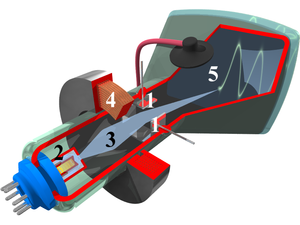Oscilloscope

- Deflection voltage electrodes
- Electron gun
- Electron beam
- Focusing coil
- Phosphor-coated inner side of the screen

An oscilloscope (sometimes abbreviated CRO, for cathode ray oscilloscope, or commonly just scope or O-scope) is a piece of electronic equipment that lets you see changes in signal voltage. For example, if you want to see the signal a small electronic timer was producing, you could connect it to an oscilloscope and see.
Usually, it shows a two-dimensional graph of one or more electrical potential differences on the vertical axis. These graphs are plotted with time or some other voltage along horizontal axis.
Description[change | change source]

A typical oscilloscope is usually box shaped with a display screen, numerous input connectors, control knobs and buttons on the front panel. To aid measurement, a grid called the graticule is drawn on the face of the screen. Each square in the graticule is known as a division.
Other websites[change | change source]
- Oscillograph 1911 Encyclopædia.
- Online oscilloscope simulation
- Oscilloscope Tutorial Archived 2007-11-25 at the Wayback Machine
- The Cathode Ray Tube site
- Digital Storage Oscilloscope measurement basics
- Oscilloscope FAQ
- Oscilloscope Articles & Resources
- Using a Common Oscilloscope Archived 2010-12-22 at the Wayback Machine
- Features of handheld Oscilloscope
- Quick and easy tutorial to learn concepts and use. Technical terms explained in clear and simple way.
